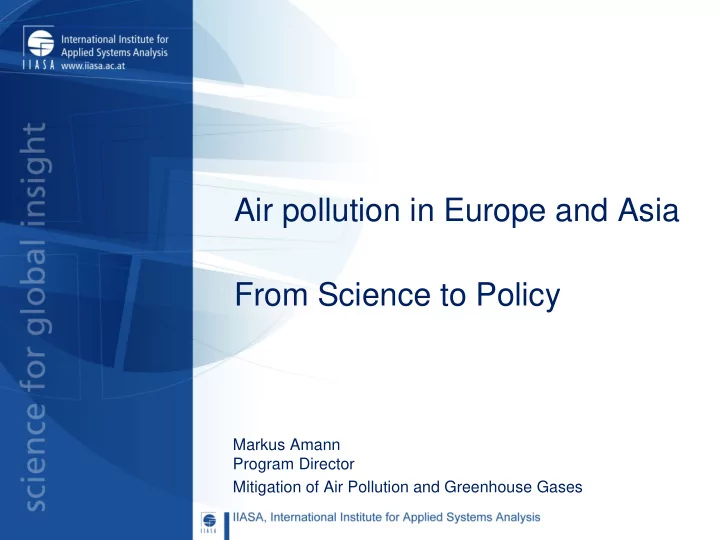

Air pollution in Europe and Asia From Science to Policy Markus Amann Program Director Mitigation of Air Pollution and Greenhouse Gases
IIASA’s GAINS systems approach to identify cost-effective emission reduction strategies Energy/agricultural projections Emission control options (~2000 measures) Emissions GAINS Costs (10 pollutants) Optimization Atmospheric dispersion Air pollution impacts, Environmental Basket of GHG emissions targets
GAINS - the central analytical tool for air pollution negotiations in Europe Convention on Long-range Transboundary Pollution 1993 Second Sulphur Protocol 1999 Gothenburg Multi-pollutant/Multi-effect Protocol 2012 Revised Gothenburg Protocol European Union 1995 EU Acidification Strategy 2001 National Emission Ceilings Directive 2005 Thematic Strategy on Air Pollution 2013 Clean Air Policy Package
The EU Clean Air Policy Package 2013 17 IIASA reports informing Commission, Council and Parliament Costs and benefits of further emission reductions in 2030 50 5 Marginal emission 45 control costs Health benefits 40 4 Economically rational 35 ambition level billion €/% gap closure 30 Billion €/yr 3 Commission 25 proposal 20 2 15 10 Emission control costs 1 5 Marginal health benefits 0 -5 0 0% 20% 40% 60% 80% 100% 120% 0% 20% 40% 60% 80% 100% 120% Scope for further measures Scope for further measures
The EU Clean Air Policy Package 2013 IIASA’s 2014 Impact Assessment for European Parliament on implications of the Climate and Energy Policy package Costs and benefits of further emission reductions in 2030 50 5 Energy Baseline 2012 45 40 4 Economically rational 35 ambition level billion €/% gap closure 30 Billion €/yr 3 Original Original 25 Commission Commission proposal proposal 20 2 Climate and Energy 15 Package 2014 10 1 5 0 -5 0 0% 20% 40% 60% 80% 100% 120% 0% 20% 40% 60% 80% 100% 120% Scope for further measures Scope for further measures
GAINS: From uncertain climate impacts of pollutants to robust win-win measures with climate co-benefits 16 practical measures that improve human Radiative forcing by substance health, increase agricultural productivity Source: IPCC AR5 and reduce near-term temperate increase: • Transport: – Diesel engines, high-emitting vehicles • Oil and gas sector: – Venting, flaring, distribution losses • Waste management: – Recycling, wastewater treatment • Heating and cook stoves: – Clean stoves, pellets • Agriculture: – Rice paddies, anaerobic digestion, open burning of residuals • Modern brick production and coke ovens
The Climate and Clean Air Coalition (CCAC) Climate and Clean Air Coalition - CCAC Global temperature 1900-2070 Reference CO 2 measures The 16 SLCP measures CO 2 + SLCP measures • Formed in 2012 to promote implementation of these 16 measures • Now 50 countries and 54 NGOs • Voluntary, action-oriented, in context with other development goals • IIASA on Science Advisory Panel
New GAINS global NH 3 emission inventory Total 2010 Livestock 2010 Fertilizer 2010 Source: GAINS model; ECLIPSE V5 scenario
Is the formation of secondary inorganic aerosols in the JingJinJi region NH 3 -limited? World Bank support to China Daily views from the 300m tower in Beijing, May 2013 A large fraction of PM2.5 in China consists of secondary inorganic aerosols, even during episodes 2014: NH 3 /nitrogen use efficiency adopted as the main direction for World Bank support for the JingJinJi Clean Air Action program of the Chinese government Availability of ‘free NH 3 ’ Air quality seen as entry point for good N management practices Severely NH 3 limited - NH 3 limited - Nitrate limited
IIASA provides the key requirements for turning scientific findings into insights relevant for decision making • Independence/perceived legitimacy of the institution • Scientific networks involving multiple disciplines • Quality control: Peer review + strict QAQC procedures • Transparency, e.g., open access to models and data • Continuous dialogue with decision makers and stakeholders
Recommend
More recommend